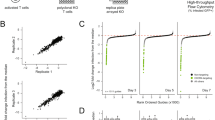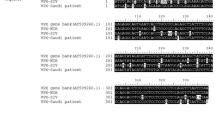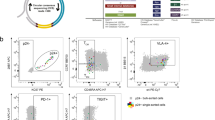Abstract
Studies of the genomic structure of human T-lymphotropic virus type III (HTLV-III) and related viruses, implicated as the causal agent of acquired immune deficiency syndrome (AIDS), have identified a sixth open reading frame in addition to the five previously known within the genome (gag, pol, sor, env and 3′orf)1–4. This gene, called tat-III, lies between the sorand env genes and is able to mediate activation, in a trans configuration, of the genes linked to HTLV-III long terminal repeat (LTR) sequences5–8. We now present evidence that the product of far-III is an absolute requirement for virus expression. We show that derivatives of a biologically competent molecular clone of HTLV-III9, in which the tat-Ill gene is deleted or the normal splicing abrogated, failed to produce or expressed unusually low levels of virus, respectively, when transfected into T-cell cultures. The capacity of these tat-III-defective genomes was transiently restored by co-transfection of a plasmid clone containing a functional tat-III gene or by introducing the tat-III protein itself. As HTLV-III and related viruses are the presumed causal agents of AIDS and associated conditions10–12, the observation that tat-III is critical for HTLV-III replication has important clinical implications, and suggests that specific inhibition of the activity of tat-III could be a novel and effective therapeutic approach to the treatment of AIDS.
This is a preview of subscription content, access via your institution
Access options
Subscribe to this journal
Receive 51 print issues and online access
$199.00 per year
only $3.90 per issue
Buy this article
- Purchase on SpringerLink
- Instant access to full article PDF
Prices may be subject to local taxes which are calculated during checkout
Similar content being viewed by others
References
Ratner, L. et al. Nature 313, 277–284 (1985).
Wain-Hobson, S., Sonigo, P., Danes, O., Cole, S. & Alizon, M. Cell 40, 9–18 (1985).
Sanchez-Pescador, R. et al. Science 227, 484–492 (1985).
Muesing, M. A. et al. Nature 313, 450–458 (1985).
Sodroski, J. G. et al. Science 227, 171–173 (1985).
Arya, S. K., Guo, C., Josephs, S. F. & Wong-Staal, F. Science 229, 69–73 (1985).
Sodroski, J. G., Patarca, R., Wong-Staal, F., Rosen, C. A. & Haseltine, W. A. Science 229, 74–77 (1985).
Rosen, C. A., Sodroski, J. G. & Haseltine, W. A. Cell 41, 813–823 (1985).
Fisher, A. G., Collalti, E., Ratner, L., Gallo, R. C. & Wong-Staal, F. Nature 316, 262–265 (1985).
Gallo, R. C. et al. Science 224, 500–503 (1984).
Barre-Sinoussi, F. et al. Science 220, 868–871 (1983).
Levy, J. A. et al. Science 225, 69–72 (1984).
Nevins, J. R., Ginsberg, H. W., Blanchard, J. M., Wilson, M. C. & Darnell, J. E. J. Virol. 32, 727–733 (1979).
Jones, N. & Shenk, T. Proc. natn. Acad. Sci. U.S.A. 76, 3665–3669 (1979).
Khoury, G. & May, E. J. Virol. 23, 167–176 (1977).
Brady, J. N., Bolen, J. B., Radonovic, M., Slazman, N. & Khoury, G. Proc. natn. Acad. Sci. U.S.A. 81, 2040–2044 (1984).
Benoist, C. & Chambon, P. Nature 290, 304–310 (1981).
Nevins, J. R. Cell 26, 213–220 (1980).
Sodroski, J. G., Rosen, C. A. & Haseltine, W. A. Science 225, 381–385 (1984).
Sodroski, J. G., Rosen, C. A., Goh, W. C. & Haseltine, W. A. Science 228, 1430–1432 (1985).
Chen, I. S. Y. et al. Science 229, 54–57 (1985).
Rosen, C. A., Sodroski, J. G., Kettman, R., Burny, A. & Haseltine, W. A. Science 227, 320–322 (1985).
Derse, D., Caradonna, S. J. & Casey, J. W. Science 227, 317–320 (1985).
Hess, J. L., Clements, J. & Narayan, O. Science 229, 482–485 (1985).
Queen, C. & Baltimore, D. Cell 33, 741–748 (1983).
Seigel, L. et al. Virology 148, 226–231 (1986).
Yoakum, G. H. Biotechniques 25, 24–30 (1984).
Harper, M. E., Marselle, L. M., Gallo, R. C. & Wong-Staal, F. Proc. natn. Acad. Sci. U.S.A. 83, 772–776 (1986).
Muligan, R. C. & Berg, P. Proc. natn. Acad. Sci. U.S.A. 78, 2072–2076 (1981).
Kaufman, J. R. & Sharp, P. A. Molec. cell. Biol. 2, 1304–1319 (1982).
Shaw, G. M. et al. Science 226, 1165–1171 (1984).
Gorman, C. M., Merlino, G. T., Willingham, M. C., Pastan, I. & Howard, B. H. Proc. natn. Acad. Sci. U.S.A. 79, 6777–6781 (1982).
Veronese di Marzo, F. et al. Virology Proc. natn. Acad. Sci. U.S.A. 82, 5199–5202 (1985).
Maniatis, T., Fitsch, E. F. & Sambrook, J. in Molecular Cloning: A Laboratory Manual, 23–233 (Cold Spring Harbor Laboratory, New York, 1982).
Aldovini, A. et al. Proc. natn. Acad. Sci. U.S.A. (submitted).
Mott, J. E., Grant, R. A., Ho, Y. S. & Plat, T. Proc. natn. Acad. Sci. U.S.A. 82, 88–92 (1985).
Author information
Authors and Affiliations
Rights and permissions
About this article
Cite this article
Fisher, A., Feinberg, M., Josephs, S. et al. The trans-activator gene of HTLV-III is essential for virus replication. Nature 320, 367–371 (1986). https://doi.org/10.1038/320367a0
Issue Date:
DOI: https://doi.org/10.1038/320367a0
This article is cited by
-
HIV Reservoir: How to Measure It?
Current HIV/AIDS Reports (2023)
-
Progress in Research and Application of HIV-1 TAT-Derived Cell-Penetrating Peptide
The Journal of Membrane Biology (2017)
-
HIV-1 Tat protein vaccination in mice infected with Mycobacterium tuberculosis is safe, immunogenic and reduces bacterial lung pathology
BMC Infectious Diseases (2016)
-
HIV-Tat immunization induces cross-clade neutralizing antibodies and CD4+ T cell increases in antiretroviral-treated South African volunteers: a randomized phase II clinical trial
Retrovirology (2016)
-
The myxobacterial metabolite ratjadone A inhibits HIV infection by blocking the Rev/CRM1-mediated nuclear export pathway
Microbial Cell Factories (2014)



